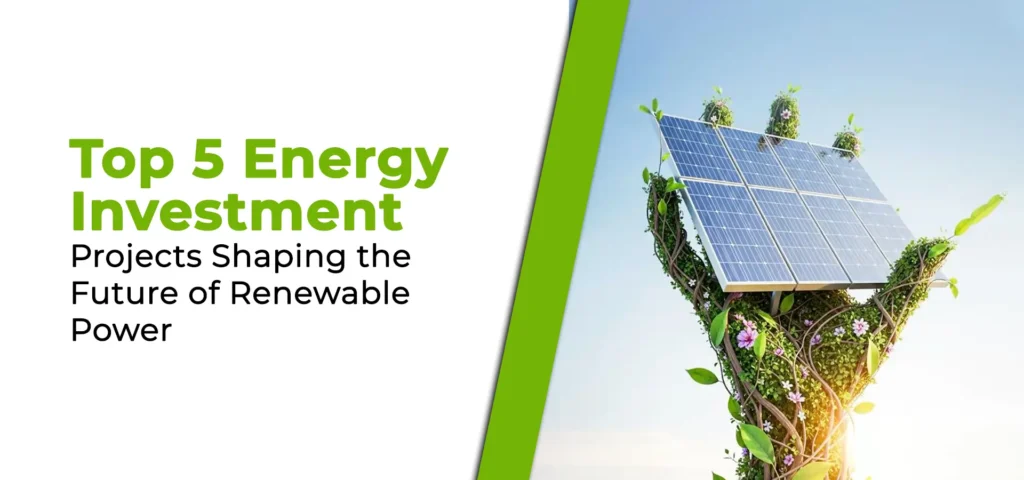Energy choices shape societies because people depend on power for homes, work and education, yet the old paths built on fossil fuels are showing heavy costs. Countries are now trying to balance growth with care for nature while also creating long term security for their people. Large renewable projects are growing because governments and investors see them as ways to solve both supply and environmental pressure together. These projects are more complex than older designs since they bring many technologies into one space and they reach sizes that were not imagined before. Five examples are being built or planned in different regions and each one shows different lessons for policy makers, investors and communities.
Gujarat Hybrid Renewable Energy Park in India
- Location: Kutch, Gujarat
- Capacity: Nearly 30 GW planned
- Technology: Combination of solar and wind generation
- Special Features: Constructed on desert land with limited farming use
In Kutch desert, large areas are being covered with panels and turbines together and this allows electricity to be produced both during sunlit hours and during windy nights. People in villages around the site hope for more jobs and small businesses since many have lived with few choices for income before this project. Investors find many fields to consider because transmission, storage and transport need strong support to carry energy safely. Costs will be heavy and stability of the grid will remain uncertain unless planning matches the scale. Still, the project stands as a step that may lead other nations with empty desert regions to follow similar approaches.
Western Green Energy Hub in Australia
- Location is Remote southern coast of Western Australia
- Capacity is Around 70 GW
- Technology is Solar and wind farms with hydrogen and ammonia production
- Special Features is Exports of renewable fuels beyond national borders
The southern coast is far from cities yet the land and wind make it suitable for huge solar fields and wide wind farms. Energy will not only supply local needs but will also be used to create hydrogen and ammonia for shipment to other nations, connecting resources with global trade. The numbers are large and so are the risks, because the place is distant and everything from roads to ports must be prepared. Many people view the hub with hope since it may bring jobs, schools and services into a region that has stayed quiet for long. International buyers will watch demand for green fuels and the hub could mark the start of new trade lines across oceans.
Dogger Bank Offshore Wind Farm in the United Kingdom
- Location is North East Coast of England
- Capacity is About 3.6 GW
- Technology is Offshore wind turbines
- Special Features is Staged construction over several years with multiple phases
Strong winds blow over sea waters and Dogger Bank takes advantage of this by building turbines far from shore. Turbines placed at sea are large and capable of producing steady electricity for millions of homes, making this project one of the most ambitious offshore ventures to date. Long blades and tall towers cut the cost of each unit produced, giving investors confidence when combined with contracts that secure purchase of power over many years. People involved in fishing and shipping sometimes raise concerns because turbines alter sea use, yet engineers are working to balance these needs. Costs are high, maintenance is tough, but the lessons gathered will guide many other nations exploring offshore construction.
Sudair Solar Power Project in Saudi Arabia
- Location is Near Sudair Industrial City
- Capacity is Around 1.5 GW
- Technology is Solar photovoltaic arrays
- Special Features is Supplies factories and urban growth
In desert land near industrial areas rows of solar panels are rising and their output is meant to power both factories and growing towns. The project is part of a wider national plan to reduce reliance on oil and it signals a shift in thinking where sunlight becomes as valuable as oil. Panels that move with the sun allow more production through the day compared with fixed systems and this raises efficiency without extra land use. Local jobs will appear during building and the hope is that services like housing and transport will expand for workers too. Dust, storms and heat are heavy problems that can lower production, so engineers must design cleaning systems and durable equipment.
West Sohag Wind Farm in Egypt
- Location: Sohag Region
- Capacity: Close to 10 GW planned
- Technology: Onshore wind turbines
- Special Features: One of the largest onshore projects in Africa
Egypt is planning a farm on land where winds blow steady and strong and the size makes it one of the biggest in Africa. The project may supply fast growing cities while also giving rural areas stronger links to modern energy. International companies are showing interest and this may bring fresh finance and also new knowledge for local teams. Employment opportunities are wide because engineers, builders and service workers will be required through every stage. Yet long transmission lines, financing risk and delays in construction remain barriers that need careful planning, otherwise power may not reach those who need it most.
Comparison of the Five Projects
| Project Name | Country | Planned Capacity | Technology Type | Main Opportunity | Main Challenge |
| Gujarat Hybrid Renewable Energy Park | India | 30 GW | Solar + Wind | Jobs, grid building, storage | Transmission and balancing |
| Western Green Energy Hub | Australia | 70 GW | Solar + Wind + Hydrogen | Export clean fuels worldwide | Remote location and cost |
| Dogger Bank Wind Farm | United Kingdom | 3.6 GW | Offshore Wind | Stable long term contracts | High sea maintenance |
| Sudair Solar Power Project | Saudi Arabia | 1.5 GW | Solar PV | Supply industry, attract investors | Harsh desert climate |
| West Sohag Wind Farm | Egypt | 10 GW | Onshore Wind | Energy security and training | Financing and transmission |
Shared Lessons
- Projects now stretch into gigawatt ranges that were rare in earlier years.
- Mixing wind, solar and fuel production allows more stable supply and wider use.
- Export plans show renewable energy is part of trade routes as oil once was.
- Long contracts give confidence to investors who need predictable returns.
- Local communities gain through employment, skills and infrastructure linked with these projects.
- Climate conditions, distance and finance make progress difficult, yet teams continue to search for workable answers.
Closing Reflection
These energy Investment projects carry more than technical meaning because they reflect human courage and desire to build a cleaner future while still feeding the needs of modern life. They show how people, money and technology can meet when societies are ready to make changes for children and grandchildren. Each one holds challenges and none are guaranteed to succeed, yet together they show a world moving step by step toward energy that is cleaner, broader and built with more care and investors may wait long years for returns but the vision of steady clean energy for future generations makes the risk worth taking.

